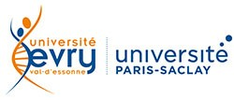

Experimental Data Tools
Next-Generation Sequencing (NGS) protocols provide powerful new approaches to study transcriptomes. These approaches, called RNA-Seq,
consist in converting transcripts to cDNAs, which are then sequenced with high coverage. Compared to microarray-based transcriptomics,
RNA-Seq provides direct access to the structure of transcripts, is not limited to a list of predefined transcripts, and covers a larger
dynamic range of expression levels.
To analyze RNA-Seq expression data for genomes included in the platform, a pipeline is integrated in MicroScope. This pipeline handles the following steps: (1) preprocessing of raw sequencing reads, (2) mapping of reads on reference genomes, (3) computation of transcript coverage along genome and expression levels for genomic objects (genes, sRNAs, ...), (4) test of differential expression between samples of distinct experimental conditions. Data and results are visualized and integrated within the web interface. Read coverages are directly plotted on IGV genome browser. Highly differentially expressed genes can be exported to gene carts and further analyzed using other MicroScope tools.
To analyze RNA-Seq expression data for genomes included in the platform, a pipeline is integrated in MicroScope. This pipeline handles the following steps: (1) preprocessing of raw sequencing reads, (2) mapping of reads on reference genomes, (3) computation of transcript coverage along genome and expression levels for genomic objects (genes, sRNAs, ...), (4) test of differential expression between samples of distinct experimental conditions. Data and results are visualized and integrated within the web interface. Read coverages are directly plotted on IGV genome browser. Highly differentially expressed genes can be exported to gene carts and further analyzed using other MicroScope tools.
Evolution projects rely on the Next Generation Sequencing (NGS) technologies to try to decipher the dynamics of genomic changes
as well as the molecular bases and the mechanisms underlying adaptative evolution of micro-organisms.
To address these problematics, we designed a bioinformatic pipeline, called SNiPer, which allows the comparison and the detection of small variations (SNPs and InDels) between sequencing reads of evolved clones and the genomic reference sequence of their ancestor. Based on the SSAHA2 package, SNiPer takes into account raw sequencing data and associated qualities to discriminate between true variations and sequencing errors.
This functionality offers different tools to explore and analyze the mutations predicted by SNiPer in their genomic and functional context.
To address these problematics, we designed a bioinformatic pipeline, called SNiPer, which allows the comparison and the detection of small variations (SNPs and InDels) between sequencing reads of evolved clones and the genomic reference sequence of their ancestor. Based on the SSAHA2 package, SNiPer takes into account raw sequencing data and associated qualities to discriminate between true variations and sequencing errors.
This functionality offers different tools to explore and analyze the mutations predicted by SNiPer in their genomic and functional context.

 Loading
Data ...
Loading
Data ...







